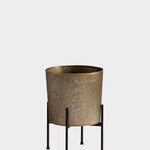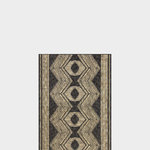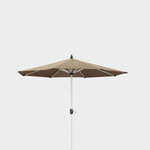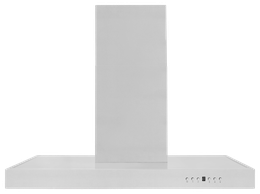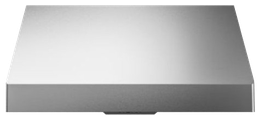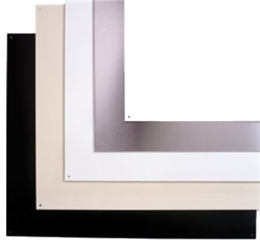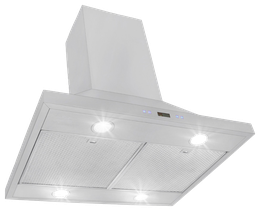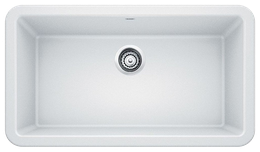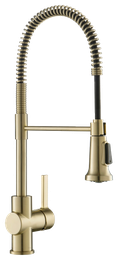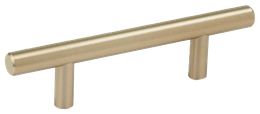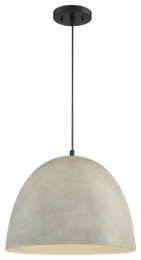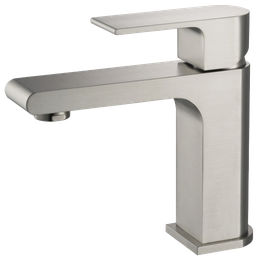FREE shipping on orders over $49!* Details
- All Products
- Kitchen & Dining
- Kitchen Appliances
- Range Hoods & Vents
Range Hoods and Vents
Item 1 of 15
Sort by:
Price
1,470 Results
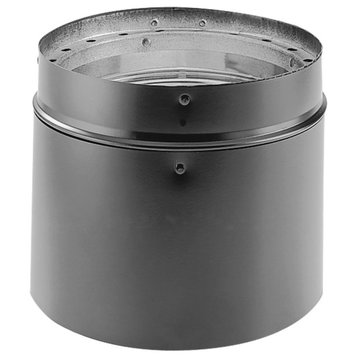
6"Diameter 6"Adjustable Lengthby DuraVent
SALE
$46$89
Use to add length to DVL pipe. 6 pipe adds 2-5 of length, 12 pipe adds 2-11 of length, when used with rigid sections of pipe. 12 section can be ovalized for oval-to-round appliance connector
Best Seller
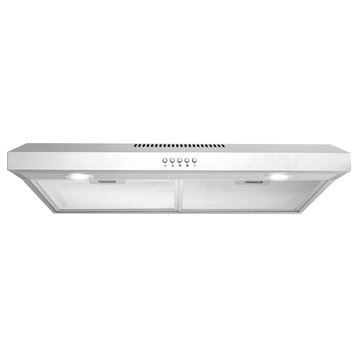
Cosmo 30" 380 CFM Under Cabinet Range Hood Kitchen Hood in Stainless Steelby Cosmo Appliances(7)
$139
Free Shipping
Cosmo's new and improved COS-5U30 Under Cabinet Range Hood has modern sharp styling for any kitchen decor. Featured in brushed stainless steel, efficient airflow removes smells and odors with ease. Two dishwasher-safe aluminum mesh filters collect unwanted grease and oil from the air. Push button controls make using hood a breeze; choose from 3 fan speeds for the right amount of suction. Built-in energy-efficient LED lighting ensures visibility for cooking at all times of the day.
- Slim profile saves space, great for condos and apartments
- Suitable for top or back venting
- 3-Speed motor to choose from high, medium and low suction to suit a verity of foods and cooking
- Noise level as low as 40 dB on lowest fan speed with rigid ducting (sold separately) under optimal conditions; range hood comes with flexible ducting for convenient installation
- Constructed with premium 430-grade stainless steel, 20-gauge thickness
- Easy push button control panel for lights, power and fan speed
- (2) 2-Watt LED energy efficient lights for year-round cost savings
- Durable reusable aluminum mesh filters included to trap grease and oil
- 4.75 in. round duct exhaust opening
- Convertible to Ductless operation with Carbon Filter Kit CFK3-TM (sold separately)
- ETL Listed: ETL Listed products demonstrate compliance to North American safety standards published by relevant NRTLs (Nationally Recognized Testing Laboratories)
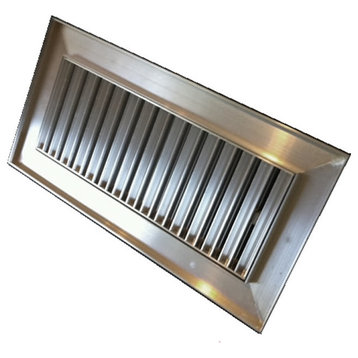
Chameleon Tile and Hardwood Vent Floor Registers, 4"x10", 1/2"by Chameleon
$130
Free Shipping
- Chameleon Tile and Hardwood Vent Floor Registers
- Net size 4" x 10" x 1/2"
- Overall Size 6" x 12"
- Available 5/16" and 1/2" Thickness with or without Air Dumper (with Air Dumper check our other listing)
- Chameleon vents stand out by blending in.
- Fill it with pieces of your flooring material and create a perfect match.
- Create a flush-mount matching register for tile and stone floors.
- Integrate job site tile or stone flooring material with an engineering strength, aluminum frame.
- Chameleon vents offer significant structural strength without having to sacrifice style for function.
- Three Easy steps and you done.
- Within minutes, experienced floor installers or handy homeowners can easily cut pieces of flooring material to fit within the Chameleon's channels.
- Start with our aluminum register and your floor material
- Cut flooring pieces: use a ceramic wet saw for ceramic and stone, and a power saw for hardwood floors, Secure pieces into register channels with clear silicone adhesive
- Install register in floor and enjoy your beautiful, integrated floor vent.
- Practical and Attractive
- Versatile
- Built To Last
- Chameleon Floor Vent Registers are made in the USA of aircraft-grade aluminum and engineered to stand up to heavy foot traffic.
- Chameleon Floor Vent Registers can be used with
- Ceramic or Porcelain Tile
- Natural Stone such as Marble, Granite and Slate
- Concrete
- Cork
- Hardwood
- Bamboo
- Laminate Flooring
- Made in the U.S.A
Best Seller
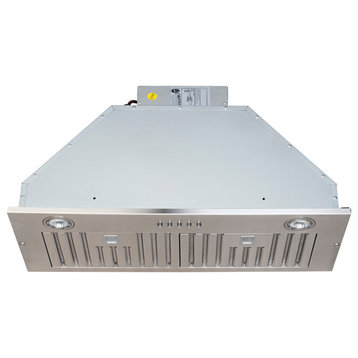
Stainless Steel Range Hood With 3 Speed Button Control, Stainless Steel, 28 in.by Home Beyond(130)
$208
- ITEM#: 33315858
- Home Beyond 600CFM Built-In / Insert Stainless Steel Range Hood 28-inch with baffle filters 3-speed control. A perfect addition to any kitchen.
Features:
- Stainless steel Insert type range hood
- 600CFM exhaust airflow
- 2 LED lights
- LED Wattage: 2x3W
- Motor Wattage: 120W
- 3 speeds push button control
- Dishwasher-safe baffle filter
- Made with premium stainless steel
- Dimensions: 28 In x 12 In
- Ducted Exhaust
- Internal Centrifugal Blower
- ETL Listed
- Warranty: Three Years Parts Warranty
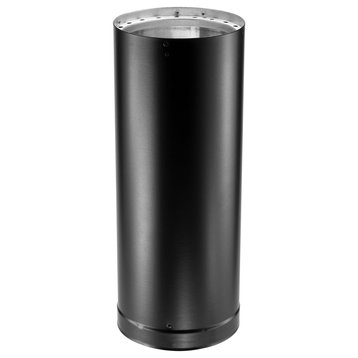
6"Diameter 12"Lengthby DuraVent
SALE
$46$73
Designed for installation with minimum clearance to combustibles (6 to walls, 8 from top of horizontal run to ceiling). Available in 6, 7, and 8 diameters. Subtract _ for installed length. Constructed with a stainless steel inner wall.
Best Seller
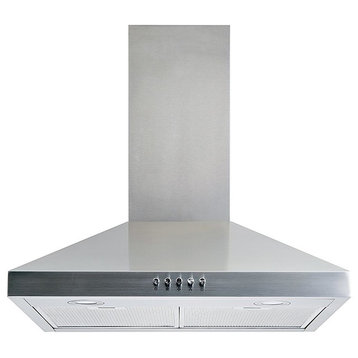
Winflo Convertible Wall-Mount Range Hood, Stainless Steel, 30"by Winflo(3007)
$217
This 30 in. wall mounted range hood is constructed of premium 430 stainless steel. Complete with aluminum mesh filters that remove smoke and grease from your cooking area and are dishwasher safe. This model also comes with 2 bright energy saver LED lights, low noise level operation, 284 CFM air flow, push button, 3-level fan speed. All the components such as damper, mounting hardware, flexible duct work and damper are included for easy installation. Adjustable and telescoping chimney can fit 7.5-8.5 ft. ceiling. This unit is convertible, can be vented out of your dwelling or recirculating (ductless) with charcoal filters (part # WRHF005S2, sold separately).
- Powerful suction operation at 284 CFM at high speed setting
- 3-speed fan levels for the right amount of suction
- Easy to operate push button control for power, fan speed and light
- Easy removable dishwasher safe aluminum mesh filters
- 2 bright energy saving soft white LED lights to illuminate your cooking area
- Installation and mounting hardware, flexible duct work and plug are all included for easy installation
- Quiet operation keeps noise level less than 65db at high speed
- Vent location is on the top, 6 in. round, connected to flexible duct work, can vent through ceiling or wall for vent out (ducted) installation
- ETL certified; 3-year limited on parts warranty
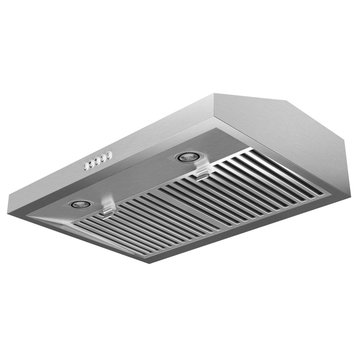
Blue Ocean 30" RH76UC Stainless Steel Under Cabinet Kitchen Range Hoodby Blue Ocean
$199
Free Shipping
- Dimension: 7”H x 29-3/4"W x 22”D (17.5 x 75.5 x 56cm)
- Stylish European Under Cabinet Range Hood with 3 Speed Button Control
- Air Flow: 300 CFM, Noise Level < 58db, Two 50W Halogen Lights
- Material: Brushed Stainless Steel Body, Two Stainless Steel Baffle Filters
- Vent at Top or Rear (Optional)
Specifications:
- Item Size: 7”H x 29-3/4"W x 22”D (17.5 x 75.5 x 56cm)
- Package Size: 25"H x 33"W x 10”D (64 x 84 x 26cm)
- Gross Weight: 39lbs
- Power Rating: 110-20V/60Hz (USA and Canada Standard)
- General Input: 230W
- Motor power: 1 x 130W
- Airflow: 300 CFM (Maximum Speed)
- Noise Level : 54db (Quiet Operation)
- Level of Speed: 3 Speeds Button Switch
- Filtration Type: 2 Stainless Steel Baffle Filters
- Illumination: 2 x 50w Halogen lights
- Ventilation Pipe Size: Diameter 6"
- Ventilation Direction: Top or Rear
- Range hood can only be vented to outdoor
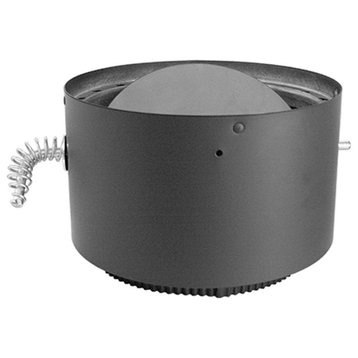
6"Diameter DVL Adapter/Damper Sectionby DuraVent(18)
SALE
$51$87
Connects DVL pipe to the appliance flue outlet. Use as a stove adapter. The damper is optional.
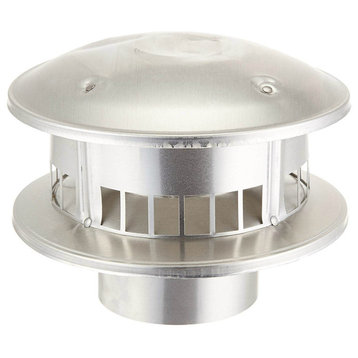
Selkirk 104800 Round Type B Gas Vent Top, 4", 4RVRTby Selkirk Corp(29)
$28
Free Shipping
The RV line of Selkirk round vent pipe and fittings is designed for use on approved gas appliances in residential and light commercial and industrial applications. Round vents for large appliances will be found in the QC section which follows.
- Size 4"
- Part No. 4RV-RT
- Measures: 8" x 4-1⁄4"
- These tops cannot be used for wood burning applications
- Helps prevent rain and debris from entering the vent
- External screen prevents entry of most bird species
Cavaliere-Euro SV218B2-30 900 CFM 30"W Stainless Steel Wall - Blackby Cavaliere-Euro(498)
$380
Free Shipping
Product Features: Powerful 900 CFM dual squirrel cage centrifugal blower with ultra quiet dual chamber motor Two dimmable 35 watt halogen lamps ensuring you always have a clear view of your cook top Six speed front mounted touch sensitive controls featuring programmable timer and 30 hour cleaning reminder with blue led lighting Includes dishwasher-safe aluminum mesh filters engineered to keep your kitchen contaminant free with optional baffle filter upgrade (b2-30, sold separately) Telescopic chimney fits up to 9 foot ceilings with optional duct cover extension for 10 foot ceilings (sold separately) Featuring your choice of 6 inch round vertical venting or non-ducted installation Features a 1 year limited factory warranty Product Technologies: Programmable Touch Sensitive Controls: Cavaliere-Euro's state of the art 4 speed electronic controls feature a delayed auto shut off function that allows you to set your range hood to continue ventilation for up to 15 minutes after you leave the cooking area, ensuring your kitchen is clear and pollutant free upon your return. Non-Ducted Range Hood (Pre-Installed): Non-ducted, or recirculating, range hoods require no external venting. Instead, air is pushed through a charcoal filtration system that removes pollutants before circulating the air back into your home. The benefit of such a system is that household temperatures and humidity are easier to maintain, as the internal air never leaves the kitchen. Recirculating range hoods are also generally far easier to install, as complex ventilation systems and vent pipe are not required. Specifications: CFM: 900 Width: 29.53" Depth: 19.69" Height: 45" Voltage: 120V Sones: 0.3 to 7.0 Blower Speeds: 6 Blower Type: Dual Centrifugal Maximum Ceiling Height: 120" Minimum Ceiling Height: 95" Minimum Height Above Cook Top: 28" Ducting: 6 Inch Round Product Variations: SV218B2-30: 30 Inch 900 CFM Wall Mounted Range Hood (This Model) SV218B2-36: 36 Inch 900 CFM Wall Mounted Range Hood
ZLINE 30 in. Wall Range Hood, Stainless Steel, KE-30by ZLINE Kitchen and Bath(917)
$435
The ZLINE KE-30 is a 30 in. professional wall mount stainless steel range hood with a modern design and built-to-last quality, making it a great addition to any kitchen. This hood's high-performance, 400 CFM 4-speed motor will provide all the power you need to quietly and efficiently ventilate your stove while cooking. With its classic 430 grade stainless steel, this range hood contains rust, temperature, and corrosion-resistant properties to ensure a durable vent hood that will last for years to come. Enjoy modern features, including built-in LED lighting for an illuminated culinary experience and dishwasher-safe stainless steel baffle filters for easy clean-up. This wall mount range hood has a convertible vent, so you can have a luxury range hood whether you need a ducted or ductless option. Enjoy easy installation and an easy recirculating conversion process. ZLINE Kitchen and Bath stands by all products with its manufacturer parts warranty. The KE-30 ships next business day when in stock.
Imperial VT0501-B R2 Wall Exhaust Dryer Vent Hood 4" with 12" Tail Pipe, Whiteby Imperial Mfg Group
$34
Free Shipping
R2 Style Wall Exhaust Hood is designed for maximum airflow. Energy efficient. Weighted damper prevents back-draft. 100% gasket seal provides quiet efficient operation. Ideal for dryer venting.
- Size: 4"
- Color: White
- Dryer vent hood
- Commercial grade heavy duty
- Paintable
- With 12" tail pipe & removable hood.
Range Hood Insert 48 Inch 1200 CFM Built-in Kitchen Hood with 4 Speed & Lights, Warm White Lightby Akicon
$1,000
Free Shipping
48 Inch Insert/Built-in Range Hood, Ultra Quiet, Powerful Suction Stainless Steel 8'' Duct Kitchen Vent Hood with Dimmable LED Light, 4-Speeds 1200CFM
ULTRA-QUIET OPERATION - The kitchen hood adopts upgraded low-noise technology and keeps the noise level below 65dB at the highest speed. Time delay turns off function from 1 to 9 minutes effortlessly and quietly removes cooking odors and smoke, no disturb, enjoy your dinner, and chill with your family.
ENERGY-EFFICIENT LED Lights - 3pcs of 6000K LED lights provide ample lighting to your cooking area while consuming less energy. We also provide 3pcs of 3500K warm Dimmable LED lights to meet different cooking needs.
HASSLE-FREE CLEANING & SUPERIOR FILTRATION - The vent hood features dishwasher-safe and easily removable stainless steel baffle filters to make maintenance a breeze. The charcoal filters are effective in capturing cooking grease and oil.
EASY TO INSTALL & USE - Whether a new renovation or replacement of an existing one, a professional instruction manual & video will help you solve all installation problems in time. Push button control can be operated easily by selecting the mode you need. ETL Certified & 3-Year Warranty. If you have any questions, please feel free to let us know.
Product Description and Features:
POWERFUL AIRFLOW - Akicon range hood insert is equipped with an excellent copper ball-bearing motor, which offers Max. 1200 CFM powerful suction, ensuring rapid and effective removal of cooking fumes, harmful smoke, and odors from your kitchen. It reduces the potential damage to your skin and health.ULTRA-QUIET OPERATION - The kitchen hood adopts upgraded low-noise technology and keeps the noise level below 65dB at the highest speed. Time delay turns off function from 1 to 9 minutes effortlessly and quietly removes cooking odors and smoke, no disturb, enjoy your dinner, and chill with your family.
ENERGY-EFFICIENT LED Lights - 3pcs of 6000K LED lights provide ample lighting to your cooking area while consuming less energy. We also provide 3pcs of 3500K warm Dimmable LED lights to meet different cooking needs.
HASSLE-FREE CLEANING & SUPERIOR FILTRATION - The vent hood features dishwasher-safe and easily removable stainless steel baffle filters to make maintenance a breeze. The charcoal filters are effective in capturing cooking grease and oil.
EASY TO INSTALL & USE - Whether a new renovation or replacement of an existing one, a professional instruction manual & video will help you solve all installation problems in time. Push button control can be operated easily by selecting the mode you need. ETL Certified & 3-Year Warranty. If you have any questions, please feel free to let us know.
Specifications:
- Package Dimensions: 50.4"(Length) x 18.1"(Width) x 22.8"(Height)
Winflo Chimney Extension for Wall-Mount Range Hood, Stainless Steelby Winflo(34)
$217
This retractable, adjustable 2 piece-built chimney extension kit will allow Winflo wall mount range hood (excluding WR003xxx series) to mount on 9 ft. to 11 ft. ceiling. The extension kit includes an upper and lower chimney that replaces the original chimney set and is adjustable/retractable according to your needs. The matching premium stainless steel surface complements your kitchen design.
- Compatible Winflo wall mount range hood models (excluding O-W103xxx series)
- Mounting bracket and hardware are included for easy installation
- Retractable, adjustable, can fit 9 ft. to 11 ft. ceiling
- Constructed with premium 430 brushed stainless steel
- Dimension: 11.9 in. (L) x 11.14 in. (D) x 35 in. - 66.9 in. (H)
- Design for Winflo wall mount range hoods, cannot guarantee compatible with range hoods from other brands
Best Seller
Wall Mount Range Hood with Permanent Filters, LED Lights, 30", Ductedby Cosmo Appliances(197)
$246
Free Shipping
Remodel your entire kitchen with Cosmo's COS-63175 modern canopy wall mount range hood. Experience premium brushed stainless steel built to withstand high heat, grease, oil and steam. Thick stainless steel is used all around to fight against accidental bumps and dents. Our wall mount range hood includes a chimney set that's seamless on all three sides for cleaner lines. Easy-to-use push button controls require no guesswork. Cook without unwanted odors and harmful air pollutants from disturbing your home. Contemporary styling is used for modern kitchen decors and an upscale luxury feel. Trust Cosmo for your next kitchen appliance.
- Wall mount range hood features ultra-quiet design to effectively remove smells and odors when cooking
- Push button controls operate the fan and lights in sleek stainless steel that integrates seamlessly with the wall mount range hood design
- 3 fan speeds to adjust to your needs, choose from high, medium and low suction to suit a variety of foods and cooking
- Noise level as low as 45 dB on lowest fan speed with rigid ducting (sold separately) under optimal conditions; range hood comes with flexible ducting for convenient installation
- Handle multiple pots, pans and burners with ease with 380CFM of suction
- Energy efficient 2-Watt LED lights helps illuminate your cooktop surface for added visibility, mounted directly below the wall mount range hood, cook and see better in the dark
- Cosmo ARC-FLOW permanent filters are constructed of high quality stainless steel to effectively capture grease and cooking odors and keep the air clean, our ARC-FLOW permanent filters are dishwasher-safe and extremely durable, no need to replace these filters, simply drop them in the dishwasher for easy maintenance
- Wall mount range hood exhaust opening uses 6 in. round duct, backdraft damper is included to prevent air coming back inside
- Wall mount range hood is made of premium 430 grade stainless steel, 20-Gauge thickness
- 2 Years limited warranty, trust our wall mount range hood to deliver years of trouble-free use
- Range hood can be converted to recirculating/ductless operation with optional purchase of Carbon Filter Kit CFK1-TM (sold separately)
- ETL Listed: ETL Listed products demonstrate compliance to North American safety standards published by relevant NRTLs (Nationally Recognized Testing Laboratories)
36" 2-Speed 4-Way Convertible Under Cabinet Range Hood, Stainless Steelby Broan NuTone LLC(8722)
$149
Free Shipping
The Broan F403604 36 In. Two-Speed 4-Way Convertible Under Cabinet Range Hood, in stainless steel, is constructed with quality, good looks and is superior to the competition whether ducted vertically, horizontally, or non-ducted. For your safety, the sides are mitered and the bottom edge hemmed, with no sharp edges, and for your convenience, the easily removable filters are dishwasher safe for simple cleaning. With its many versatile installation options and powerful but incredibly quiet 160-190 CFM blower, this is the perfect range hood for any type of kitchen.
Broan SP3004 30" Stainless Steel Backsplash - Stainless Steelby Broan NuTone LLC(570)
SALE
$59$70
Free Shipping
30" - Model SP3004 Help keep your kitchen looking like new, with a Broan splash plate. Provides easy clean-up of cooking splatter Stainless Steel finish Available in 24", 30", "36" Or 42" Width; all are 24" High Mounting hardware not included
Air King SP2430W 30"W x 24"H Range Hood Back Splash - Whiteby Air King(1)
SALE
$41$74
Free Shipping
30" Wide x 24" High Range Hood Back SplashProtect the wall behind your cooking surface with an Air King Back Splash, designed to match both the finish and size of your range hood.Over the forty years Air King has been in business, they have developed something of a reputation for manufacturing quality ventilation products, offering products at a good value, and providing excellent service for their products. Air King believes that a home is more than just a house, it is a sanctuary from the busy world, so shouldn't it be comfortable as well? Their mission is to make homes healthier, more comfortable, and more convenient, and they have delivered for over 40-years.Features:
*Dimensions: 30" Width x 24" Height
*Dimensions: 30" Width x 24" Height
Best Seller
Cavaliere Wall Mounted Stainless St Kitchen Range Hood, 30"by Ariel Bath(656)
$448
- Mounting Type - Wall Mounted
- 900 CFM centrifugal blower
- Delayed power auto shut off (programmable 1-15 minutes)
- 30 hours cleaning reminder
- Two dimmable 35W halogen lights (GU-10 type light bulbs)
- Aluminum 6 layers micro-cell washable grease filters (dishwasher-friendly)
- Heavy duty 21 gauge stainless steel (brushed finish)
- Telescopic decorative chimney fits up to a 9' ceiling
- 6" round duct vent exhaust and back draft damper
- Full stainless steel construction
- Venting Mode: Duct (optional re-circulating kit available for ductless)
- One year limited factory warranty
Cosmo 380 CFM Wall Mount Vent Range Hood With Permanent Filters & Glass Canopy, 30", Ductedby Cosmo Appliances(12)
$266
Free Shipping
Elevate your kitchen decor to new heights. Cosmo's COS-668A750 wall mount range hood features a stainless steel body with a tempered glass visor. Heavy duty stainless steel permanent filters are dishwasher safe for easy clean-up. 380 cu. ft. per minute suction traps smoke and fumes from disturbing your home. The glass visor captures smoke and steam, ensuring it doesn't escape into your home. Energy efficient LED lighting is included to illuminate your cooktop. Featuring touch controls and a 3-prong power plug for easy use.
- Push button controls make operating our wall mount range hood easy to control with just a tap of a finger
- 3 fan speeds to adjust to your needs, choose from high, medium and low suction to suit a variety of foods and cooking
- Noise level as low as 50 dB on lowest fan speed with rigid ducting (sold separately) under optimal conditions; range hood comes with flexible ducting for convenient installation
- Energy efficient 2-Watt LED lights helps illuminate your cooktop surface for added visibility, mounted directly below the range hood, cook and see better in the dark
- Cosmo ARC-Flow permanent filters are constructed of high quality stainless steel to effectively capture grease and cooking odors and keep the air clean, our ARC-Flow permanent filters are dishwasher-safe and extremely durable, no need to replace these filters, simply drop them in the dishwasher for easy maintenance
- Range hood can be converted to recirculating/ductless operation with optional purchase of Carbon Filter Kit CFK1-TM (sold separately)
- 2 Years limited warranty, trust our wall mount range hood to deliver years of trouble-free use
- Wall mount range hood with telescoping chimney makes it suitable for ceilings 7.5 ft. to 8.5 ft. in height
- Wall mount range hood is made of premium 430 grade stainless steel, 20-Gauge thickness
- 3-prong power plug
- ETL Listed: ETL Listed products demonstrate compliance to North American safety standards published by relevant NRTLs (Nationally Recognized Testing Laboratories)
Best Seller
Hauslane | Chef Series PS18 Under Cabinet Kitchen Range Hoods, Matte White, 30"by Hauslane(1295)
We’re bringing professional-quality range hoods to your home kitchen with our Chef Series under cabinet range hood line. Backed by dual motors and powerful suction technology, this range hood is designed to make extracting odors, fumes, and chemicals from your kitchen a breeze. With the easy-to-use buttonless system, you can cut down on clean up time and keep your home smelling fresh with a few taps on the digital touch screen.
No more deciding between a clean kitchen and a delicious meal. You can cook your favorites as often as you’d like without having to deal with noxious odors, greasy particles, and stained cabinets. Easily control the suction power and noise levels with our unique six-way setting system. Our energy-saving LED lights provide the perfect amount of light and can be quickly replaced as needed.
We know how valuable your time is. That’s why we’re giving you more time to try new recipes, whip up old favorites, and spend time with your loved ones. Instead of wasting hours trying to remove grease from the crevices of your range hood, you can simply pop up out the baffle filters and run them through the dishwasher. A quick wipe-down of the stainless steel surface, and you’re set!
$450
Free Shipping
Features:
- Contemporary, sleek design with clean lines and modern finish, includes buttonless system, digital kitchen clock, baffle filters, and touch screen
- Top of the line CFM suction power, ideal for heavy-duty cooking including heat, and smoke; boiling, steaming, poaching, braising, frying, searing, and sauteing
- Versatile venting system comes with 3 different options: vertical 6” round, vertical 3-1/4 x 10 rectangular, or horizontal 3-1/4 x 10
- Energy-saving LED lights with standard 2700K light color for a warm glow
- Control suction power and noise level with variable six-speed setting, backed by powerful dual motors
- Baffle filters’ deep groove design catches grease drip before it can make its way onto your cooktop or even worse, your food
- Low-maintenance: simply remove the stainless steel baffle filters and place them into the dishwasher for a thorough cleaning
- Delay auto shut-off function means you’ll never have to remember to turn off your range hood again
- Easy under the cabinet install.
- Includes: oil tray (1), dishwasher-safe baffle filters (2), top 6” round exhaust adapter (1), aluminum foil tape (1), microfiber cloth (1), top 3-¼” by 10” rectangular exhaust adapter (1), and rear 3-¼” by 10” rectangular exhaust adapter (1)
- 2-year limited warranty and lifetime warranty on motors
Product Description:
The kitchen is one of the most high-traffic areas in your home. It’s the place where memories are made, family traditions are created, and moments are shared. When you think about the must-haves for your kitchen, stoves, ovens, and dishwashers likely come to mind. But what about your range hood? This unsung hero of appliances has been recognized by chefs for decades as a key piece of any effective kitchen.We’re bringing professional-quality range hoods to your home kitchen with our Chef Series under cabinet range hood line. Backed by dual motors and powerful suction technology, this range hood is designed to make extracting odors, fumes, and chemicals from your kitchen a breeze. With the easy-to-use buttonless system, you can cut down on clean up time and keep your home smelling fresh with a few taps on the digital touch screen.
No more deciding between a clean kitchen and a delicious meal. You can cook your favorites as often as you’d like without having to deal with noxious odors, greasy particles, and stained cabinets. Easily control the suction power and noise levels with our unique six-way setting system. Our energy-saving LED lights provide the perfect amount of light and can be quickly replaced as needed.
We know how valuable your time is. That’s why we’re giving you more time to try new recipes, whip up old favorites, and spend time with your loved ones. Instead of wasting hours trying to remove grease from the crevices of your range hood, you can simply pop up out the baffle filters and run them through the dishwasher. A quick wipe-down of the stainless steel surface, and you’re set!
Specifications:
- Size : 30" | 36"
- Style : Under Cabinet
- Cleaning Function : N/A
- Noise Level : 1.5 to 3.8 Sones
- Light Color Temp. : Warm / 2700 Kelvin
- Light Bulb : 3W LED (GU10 Base)
- Light Intensity : 1 Level
- Control : Touch Panel
- Speed Selections : 6
- Top Venting : 6" or 3-1/4" x 10"
- Rear Venting : 3-1/4" x 10"
- Convertible : N/A
- Motor : Dual
- Wattage : 266W
- Voltage : 120v
- Amperage : 2.2 Amp
- Dimensions (WxDxH) : 29-3/4" | 35-3/4" x 22" x 8-1/8"
- Certification: ETL
Hauslane | Chef Series Range Hood WM-739 European Style Kitchen Extractor, 30"by Hauslane(37)
$400
Free Shipping
- CONTEMPORARY RANGE HOOD: This wall mount extractor’s contemporary design of tempered glass and stainless steel creates a bold, clean, and minimal statement suited to a modern or professional style kitchen.
- POWERFUL VENTILATOR: Strong suction removes fumes and food smells from your kitchen during and after cooking with incredibly quiet, 3-speed extraction.
- DISHWASHER SAFE FILTER: Forget about washing the filters with your hands, just put them in the dishwasher. Clean filters will keep your range hood’s ventilation functioning at its best.
- TOUCH CONTROL DISPLAY: Easily adjust your kitchen extraction setting by using the range hood’s intuitive touch controls, with LED lights for daytime and nighttime cooking control.
- IDEAL FOR HIGH CEILING & DUCTLESS KITCHEN: We have extended chimney cover to meet your 10-foot high ceiling kitchen. Measurements: 1' x 11" x 2'8". Our charcoal filters are very effective to trap grease and remove odor. It’s the perfect solution for a ductless kitchen. Chimney extension and charcoal filters sold separately.
- POWERFUL VENTILATOR: Strong suction removes fumes and food smells from your kitchen during and after cooking with incredibly quiet, 3-speed extraction.
- DISHWASHER SAFE FILTER: Forget about washing the filters with your hands, just put them in the dishwasher. Clean filters will keep your range hood’s ventilation functioning at its best.
- TOUCH CONTROL DISPLAY: Easily adjust your kitchen extraction setting by using the range hood’s intuitive touch controls, with LED lights for daytime and nighttime cooking control.
- IDEAL FOR HIGH CEILING & DUCTLESS KITCHEN: We have extended chimney cover to meet your 10-foot high ceiling kitchen. Measurements: 1' x 11" x 2'8". Our charcoal filters are very effective to trap grease and remove odor. It’s the perfect solution for a ductless kitchen. Chimney extension and charcoal filters sold separately.
Specifications
Dimensions (WxHxD):
- 30'': 30" x 20" x 20-38"
- Filter Types: 2 x Baffle Filters
- Speed Selection: 3 Speed
- Control: Touch Screen
- Clock: Yes
- Lamp: LED
- Exhaust Type: 6" Round Vertical Ducting
- Net Weight: 46 lbs
Best Seller
Winflo Convertible Wall-Mount Range Hood, Black, 30"by Winflo(1237)
SALE
$286$321
This 30 in. wall mounted range hood is constructed of premium powder coated steel steel. Complete with black mesh filters that remove smoke and grease from your cooking area and are dishwasher safe. This model also comes with 2 bright energy saver LED lights, low noise level operation, 284 CFM air flow, push button, 3-level fan speed. All the components such as damper, mounting hardware, flexible duct work and damper are included for easy installation. Adjustable chimney can fit 7.5-8.5 ft. ceiling. This unit is convertible, can be vented out of your dwelling or recirculating (ductless) with charcoal filters (part # WRHF005S2, sold separately).
- Powerful suction operation at 284 CFM at high speed setting
- 3-speed fan levels for the right amount of suction
- Easy to operate push button control for power, fan speed and light
- Easy removable dishwasher safe mesh filters in black
- 2 bright energy saving soft white LED lights to illuminate your cooking area
- Installation and mounting hardware, damper, flexible duct work and plug are all included for easy installation
- Quiet operation keeps noise level less than 65db at high speed
- Vent location is on the top, 6 in. round, connected to flexible duct work, can vent through ceiling or wall for vent out (ducted) installation
- ETL certified; 3-year limited on parts warranty
30" Ductless Under Cabinet Range Hood With Soft Touch Controlby Cosmo Appliances(55)
$267
Give your kitchen a professional look with Cosmo's UMC30-DL ductless stainless steel range hood Featuring a sleek touchscreen and backlit display, you can control your fan speed, turn on the energy-efficient LED lights, or enable the timer with just a few taps Our range hood is efficient and unobtrusive, moving 380 CFM of air, and dishwasher-safe, permanent stainless steel filters make clean-up a breeze Our carbon filter kit is included for ductless and recirculating installation Includes a 120V 3 prong power cord included for ease of installation Cosmo Appliances are designed to give you professional luxury at factory-direct prices
- Ultra-quiet ductless range hood mounts underneath your kitchen cabinets
- Easy-to-use digital soft-touch controls with backlit display built-in to the under cabinet range hood
- 3 fan speeds to adjust to your needs, choose from high, medium, and low suction to suit a variety of foods and cooking
- Noise level as low as 45 dB on lowest fan speed with rigid ducting (sold separately) under optimal conditions; range hood comes with flexible ducting for convenient installation
- 380 CFM airflow capacity provides efficient performance
- 2 high efficiency LED lights to illuminate the cooktop surface with bright white light
- Cosmo ARC-FLOW permanent filters are constructed of high-quality stainless steel to effectively capture grease and cooking odors and keep the air clean; our ARC-FLOW permanent filters are dishwasher-safe and extremely durable; no need to replace these filters, simply drop them in the dishwasher for easy maintenance
- Auto shut-off timer for multi-tasking and removal of lingering odors
- Carbon filter kit lasts up to 6 months depending on use, replacements available for optimum performance (Purchase Part # CFK1-TM)
- Ductless wall mount range hood features 6-inch round exhaust opening Ducting must be purchased separately for ducted application
- This under cabinet range hood is made of premium 430-grade stainless steel, 20-Gauge thickness
- 120V 3-prong power cord included for ease of installation
- 2-year limited parts warranty, our under cabinet range hood will deliver years of trouble-free use
Best Seller
30" Ductless Wall Mount Range Hood, Stainless Steel With Soft Touch Controlby Cosmo(13)
SALE
$280$385
Cosmo's COS-668WRCS75-DL combines curved glass and stainless steel perfect for any modern kitchen The flowing designs of our ductless 30" wall mount range hood come with a 380 CFM centrifugal motor that traps smoke and fumes from lingering in your home Cosmo Range Hoods include ARC-FLOW Permanent Filters, the only filters that provide greater airflow and are dishwasher-safe for easy clean-up Soft-touch digital controls manage multiple functions, including 3 fan speeds and LED lighting for added visibility This ductless range hood includes a 3-prong power plug for easy use
- Ductless range hood designed for wall mounting features an ultra-quiet design to effectively remove smells and odors when cooking, the included carbon filter kit is used for ductless and recirculating installation
- Soft touch digital controls make operating our 380CFM wall mount range hood easy to control with just a tap of a finger
- 3 fan speeds to adjust to your needs, choose from high, medium, and low suction to suit a variety of foods and cooking
- Noise level as low as 50 dB on lowest fan speed with rigid ducting (sold separately) under optimal conditions; range hood comes with flexible ducting for convenient installation
- Energy-efficient 2-Watt LED lights helps illuminate your cooktop surface for added visibility, mounted directly below the range hood, cook and see better in the dark
- Cosmo ARC-FLOW permanent filters are constructed of high-quality stainless steel to effectively capture grease and cooking odors and keep the air clean ARC-FLOW technology is exclusive to Cosmo Range Hoods and these permanent filters are the only filters on the market that provide greater airflow Our ARC-FLOW permanent filters are dishwasher-safe and extremely durable No need to replace these filters, simply drop them in the dishwasher for easy maintenance
- Ductless wall mount range hood with telescoping chimney makes it suitable for ceilings 7.5 ft to 8.5 ft in height
- Ductless wall mount range hood is made of premium 430-grade stainless steel, 20-Gauge thickness
- The included carbon filter kit installs onto each side of the motor, and installation is easy, simply align and twist to lock into place for ductless applications of this wall mount range hood
- Carbon filter kit lasts up to 6 months depending on use, replacements available for optimum performance (Purchase Part # CFK1-TM)
- 2 Years limited warranty, trust our wall mount range hood to deliver years of trouble-free use
- 3-prong power plug
- ETL Listed: ETL Listed products demonstrate compliance to North American safety standards published by relevant NRTLs (Nationally Recognized Testing Laboratories)
Best Seller
Winflo Chimney Extension for Wall-Mount Range Hood, Stainless Steelby Winflo(39)
$196
This retractable, adjustable 2 piece-built chimney extension kit will allow Winflo WR001xxx series wall mount range hood to mount on 9 ft. to 11 ft. ceiling. The extension kit includes an upper and lower chimney that replaces the original chimney set and is adjustable/retractable according to your needs. The matching premium stainless steel surface with curve edges complements your kitchen design.
- Compatible Winflo O-W101xxx series wall mount range hood models
- Mounting bracket and hardware are included for easy installation
- Retractable, adjustable, can fit 9 ft. to 11 ft. ceiling
- Constructed with premium 430 brushed stainless steel
- Dimension: 11.9 in. (L) x 11.14 in. (D) x 35 in. - 66.9 in. (H)
- Design for Winflo wall mount range hoods, cannot guarantee compatible with range hoods from other brands
Hauslane | Chef Series Range Hood B018 30" Under Cabinet Kitchen Extractorby Hauslane(38)
$220
Free Shipping
Features:
- Quiet, efficient motor to handle basic cooking needs, making it perfect for light cooking, heat, and smoke; boiling, steaming, and poaching
- Under-cabinet range hood with sleek, minimalist design
- 3-way venting or ventless option
- Simple to use electronic buttons, illuminated by LED lights
- Durable, hybrid baffle with aluminum mesh filters to trap grease particles from cooking fume
- Bright LED strip for the perfect amount of light
- Stainless steel body and dishwasher safe filters make maintenance a breeze
- Includes: dishwasher-safe baffle filters (2), 3-¼ X 10 rectangular adapter (1), 7” round adapter (1)
- 2-year limited warranty and lifetime warranty on motors
Product Description:
At Hauslane, we know under cabinet range hoods don’t have to be bulky eyesores to deliver superior performance. That’s why we’re proud to offer range hoods like our UC-B018 model in stainless steel. Don’t let the compact appearance fool you. This stainless range hood vent delivers the ideal amount of suction power for home kitchens like yours.Selkirk DSP6E9-1 90-Degree Elbow, 6", Matte Blackby Selkirk Corp
SALE
$99$137
Free Shipping
The vital link between your wood stove & insulated stainless steel chimney. Lasts significantly longer than single wall stove pipe. Only 6” clearance to combustible materials. Stainless steel inner liner. Black enamel finish. Easy to install
- 90 degree Elbow
- Lasts significantly longer than single wall stove pipe
- Only 6” clearance to combustible materials
- Stainless steel inner liner
- Aluminized steel outer casing
- 1/4” air insulation
- Black enamel finish
- Easy to install
- Certified to UL & ULC standards.
Streamline 30" Giotto Ductless Wall Mount Range Hood, Stainless Steelby Streamline
SALE
$164$238
Enhance your kitchen's atmosphere with our modern Streamline 30 in. Giotto Ductless Wall Mount Range Hood in Brushed Stainless Steel. This sleek range hood features a potent 350 CFM speed and a versatile 3-speed touch pad control, effortlessly clearing away cooking odors. Two integrated LED lights illuminate your cooking area, while the sturdy stainless steel baffle filters ensure easy upkeep and efficient grease capture. Installation is a breeze thanks to the user-friendly 3-prong 120-volt power cord. Opt for contemporary functionality and design for your culinary sanctuary.
This range hood features a telescopic chimney that can be adjusted to fit your needs. For more precise measurements, please refer to the item's specification sheet.
- Overall Range Hood Dimensions: 29.3'' L x 19.7'' W x 26.8''-40.5'' H
- The range hood is prepared for ductless installation out of the box.
- Elegant brushed steel finish seamlessly complements other kitchen hardware finishes
- A versatile 3-speed fan control (200/280/350 CFM) allows for easy and seamless adjustment based on your specific cooking needs.
- The range hood's 350 CFM air flow ensures ample suction power to effectively eliminate any odors or smells that may arise during cooking.
- With a centrifugal fan design made entirely of metal, this range hood operates both efficiently and quietly.
- Experience a peaceful cooking environment with noise levels kept below 62 dB at maximum speed, ensuring a quiet atmosphere in your kitchen.
- Touch-enabled, backlit LED display provides convenient operation, enabling seamless transitions between fan modes and lighting control.
- For effortless installation, this product includes all the necessary mounting hardware.
- This range hood features a standard 6-inch round duct opening. The vent is located on the top of the range hood.
- The range hood is equipped with two 5300K, 31 lumen, 1.5W, LED white lights, providing ample illumination for the cooking area beneath it.
- Certification: ETL Certified
- 3 Year Limited Manufacturer's Warranty
- To facilitate multitasking and effectively eliminate lingering odors, this range hood is equipped with an auto shut-off timer function.
This range hood features a telescopic chimney that can be adjusted to fit your needs. For more precise measurements, please refer to the item's specification sheet.
Best Seller
Castlewood Traditional Chimney Hood - Maple, 36", No Ventilator/Linerby Castlewood(11)
$1,265
Free Shipping
Castlewood's SY-WCH Traditional Chimney style Range Hoods will add a warmth and a traditional ambiance to any design. Constructed of hardwood plywood and solid lumber, these hoods can be embellished to fit a variety of tastes.
- Range hoods are large shipments and thus are shipped LTL freight. If this is being shipped to a residence, the carrier will contact you to schedule a delivery appointment.
- This range hood qualifies for FREE SHIPPING! The hood, ventilator, and liner will be securely wrapped and packaged on a pallet. The pallet will be delivered LTL Freight through one of our approved carriers. Free shipping includes all the fees associated with a freight shipment like residential delivery fees and lift gate service fees. The lift gate service is used on residential deliveries, by the carrier, to lower the pallet off the truck so you do not have to off load it yourself.
AVAILABLE SIZES:
- SY-WCH30: 44-1/2" H | 33-1/8" W | 21-1/2" D
- SY-WCH36: 44-1/2" H | 39-1/8" W | 21-1/2" D
- SY-WCH42: 44-1/2" H | 45-1/8" W | 21-1/2" D
- SY-WCH48: 44-1/2" H | 51-1/8" W | 21-1/2" D
Features:
- Hardwood Plywood and Solid Lumber Construction
- 1/2" Rear Plywood Stretchers for wall mounting
- Select from Ascension 350, 500, 620 or 900 CFM Ventilation power packs
- Liner included
- Includes standard 14" height Chimney Extension
- Optional 24" and 36" height Chimney Extensions available
Additional Info:
- These wood range hood covers are designed to accept the liners and ventilators listed on this page as options. If you have a third party ventilator, please contact us to make sure the unit will fit. Most third party ventilators will require customization to the hood.
- Range hoods are large shipments and thus are shipped LTL freight. If this is being shipped to a residence, the carrier will contact you to schedule a delivery appointment.
- This range hood qualifies for FREE SHIPPING! The hood, ventilator, and liner will be securely wrapped and packaged on a pallet. The pallet will be delivered LTL Freight through one of our approved carriers. Free shipping includes all the fees associated with a freight shipment like residential delivery fees and lift gate service fees. The lift gate service is used on residential deliveries, by the carrier, to lower the pallet off the truck so you do not have to off load it yourself.
Hauslane | Chef Series Range Hood PS10 30" Under Cabinet Kitchen Extractorby Hauslane(182)
This workhorse of a vent hood allows you to customize your performance and lighting. Select from 3 variable speed settings for the exhaust fan and 2 lighting options with LED bulbs. The slim profile makes it an easy fit for 30-in standard cabinets as well as compact spaces. Whether you’re whipping up your favorite meal in a large, open-concept kitchen or cozy apartment-style kitchen, you’ll love the ventilation this 30-inch range hood provides. The delayed auto-shutoff function ensures that your kitchen is always well ventilated while giving you more time to savor your latest dish.
Oh, and no messy clean up to deal with either. Not only does the oven hood vent suck excess grease and fumes, but it’s also beyond easy to clean. Simply wipe down the surface and run the internal baffle filters in the dishwasher.
We’d be remiss not to mention the looks on this model! The clean lines, industrial styling, and stainless steel range body are a universal fit for any kitchen. The professional appearance is backed by restaurant-quality performance, something any home chef will certainly enjoy!
$380
Free Shipping
Features:
- Clean, sharp lines and stainless steel body for a professional, timeless look
- Powerful dual motors keep things humming and your kitchen smelling fresh, ideal for heavy-duty cooking methods including heat, and smoke; boiling, steaming, poaching, braising, frying, searing, and sauteing
- Variable 3-speed exhaust fan settings with an easy-to-use touch screen
- Dishwasher-safe baffle filters catch grease fast and are easy to clean
- Bright, energy-saving LED lights with two settings, so you always have the ideal amount of light
- Touch screen panel for simple maintenance and use
- Delayed auto-shutoff to fully remove all lingering odors and fumes
- Vent hood comes with 6-inch round adapter with dampers
- 2-year limited warranty and lifetime warranty on motors
- Includes: dishwasher-safe baffle filters (3), stainless steel oil tray (1), and 6-inch round exhaust adapter (1)
Product Description:
If you love efficiency and professional-level performance, you’ll love this range hood. Ideal for the home chef who loves to experiment in the kitchen, this under cabinet range hood features dual motors, powerful suction technology, and 3-speed exhaust fan settings. The extractor fan quickly sucks up grease, smoke, fumes, and odors, leaving your kitchen smelling fresh. No need to worry about a noisy performance- our dual motors are designed to run efficiently and quietly.This workhorse of a vent hood allows you to customize your performance and lighting. Select from 3 variable speed settings for the exhaust fan and 2 lighting options with LED bulbs. The slim profile makes it an easy fit for 30-in standard cabinets as well as compact spaces. Whether you’re whipping up your favorite meal in a large, open-concept kitchen or cozy apartment-style kitchen, you’ll love the ventilation this 30-inch range hood provides. The delayed auto-shutoff function ensures that your kitchen is always well ventilated while giving you more time to savor your latest dish.
Oh, and no messy clean up to deal with either. Not only does the oven hood vent suck excess grease and fumes, but it’s also beyond easy to clean. Simply wipe down the surface and run the internal baffle filters in the dishwasher.
We’d be remiss not to mention the looks on this model! The clean lines, industrial styling, and stainless steel range body are a universal fit for any kitchen. The professional appearance is backed by restaurant-quality performance, something any home chef will certainly enjoy!
Specifications:
- Size : 30"
- Style: Under Cabinet
- Cleaning Function: N/A
- Noise Level: 1.5 to 4.0 Sones
- Light Color Temp. : White / 5000 Kelvin
- Light Bulb: 2W Integrated LED
- Light Intensity: 2 Levels
- Control: Touch Panel
- Speed Selections : 3
- Top Venting: 6" Round
- Rear Venting: N/A
- Convertible: N/A
- Motor: Dual
- Wattage: 203W
- Voltage: 120v
- Amperage: 1.69 Amp
- Dimensions (WxDxH) : 29-3/4" x 22" x 8-3/4"
Best Seller
Cosmo 380 CFM Euro Stainless Steel Island Glass Range Hood With Permanent Filter, 30", Ductedby Cosmo Appliances(13)
$383
Free Shipping
Cosmo presents a beautiful Italian-style designer range hood that's truly in a class of its own. With details like a sleek brushed stainless steel body and a tempered glass visor, this island range hood is coveted by kitchen design experts for its sophisticated, ultra-modern aesthetic. This island range hood brings modern features into your kitchen, with high-lumen LED lighting, digital touch controls, including 3 fan speeds, a clock and timer, and an efficient 380 CFM motor that pulls lingering grease and odors from your house with ease. Premium stainless steel ARC-FLOW permanent filters make maintenance a breeze, simply drop the filters in the dishwasher, no replacement required.
- Island range hood with ultra-quiet design and glass visor
- Easy-to-use digital touch controls with timer and clock
- Choose from 3 fan speeds from high, medium and low to suit a variety of cooking styles
- Handle multiple pots, pans and burners with ease with 380CFM of suction- enough to take care of steam, grease and smoke from even the largest meals
- Noise level as low as 45 dB on lowest fan speed with rigid ducting (sold separately) under optimal conditions; range hood comes with flexible ducting for convenient installation
- 4 LED lights mounted below the island range hood helps illuminate the cooktop surface with bright white light
- Cosmo ARC-FLOW permanent filters are constructed of high quality stainless steel to effectively capture grease and cooking odors and keep the air clean. Our ARC-FLOW permanent filters are dishwasher-safe and extremely durable; no need to replace these filters, simply drop them in the dishwasher for easy maintenance
- Island range hood exhaust opening uses 6 in. round duct. A backdraft damper is included to prevent air coming back inside
- Island range hood is made of premium 430 grade, 20 Gauge stainless steel
- Convertible to ductless operation with Carbon Filter Kit # CFK1-TM (sold separately)
- ETL Listed: ETL Listed products demonstrate compliance to North American safety standards published by relevant NRTLs (Nationally Recognized Testing Laboratories)
Winflo Chimney Extension for Wall-Mount Range Hood, Stainless Steelby Winflo(167)
$156
This retractable, adjustable 2 piece-built chimney extension kit will allow Winflo O-W103xxx series wall mount range hood to mount on 9 ft. to 11 ft. ceiling. The extension kit includes an upper and lower chimney that replaces the original chimney set and is adjustable/retractable according to your needs. The matching premium stainless steel surface complements your kitchen design.
- Compatible Winflo O-W103xxx series wall mount range hood models
- Mounting bracket and hardware are included for easy installation
- Retractable, adjustable, can fit 9 ft. to 11 ft. ceiling
- Constructed with premium 430 brushed stainless steel
- Dimension: 8.38 in. (L) x 7.32 in. (D) x 32.67 in. - 62.2 in. (H)
- Design for Winflo wall mount range hoods, cannot guarantee compatible with range hoods from other brands
24" 2-Speed Non-Ducted Under Cabinet Range Hood, Stainless Steelby Almo Fulfillment Services(1264)
$109
Free Shipping
The Broan 412404 24 In. Two-Speed Non-Ducted Under Cabinet Range Hood, in stainless steel, is Broan's most economical non-ducted hood with filtration of airborne cooking contaminants. The unit is non-ducted and has a non-ducted filter to remove smoke and odors. The sides are mitered and the bottom edge hemmed, with no sharp edges for safety and good looks. The unit has separate rocker-type fan and light switches plus a protective lens covers the light bulb to distribute light evenly over the entire cook top area.
Broan BCSD136 150 - 250 CFM 36"W Under Cabinet Range Hood - Stainless Steelby Broan NuTone LLC(103)
$259
Free Shipping
Features: Features a powerful 250 CFM blower to quickly clear residual heat and unwanted air pollution Dishwasher safe and easy to replace mesh filters trap and remove unwanted contaminants such as grease and food residue Two halogen bulbs (not included) provide warm light over the cooking surface, adjustable to high or low levels Convertible to ducted or non-ducted operation This range hood is ADA compliant with the use of a UL listed remote switch This product is UL listed Includes damper Covered under a 1-year limited warranty Product Technologies: Halogen Lighting: Light your kitchen workspace with brilliant halogen light. This hood is equipped with halogen lights with two levels of intensity (sold separately). Quiet Operation: Keep your kitchen conversational with the installation of this hood. It has a speed setting that maintains minimal noise levels, keeping you and your guests talking. Captur™ Blower: The Captur™ system’s advanced blower design features a forward positioned centric inlet to remove smoke and odor faster Specifications: CFM: 150, 250 Sones: 1.5 Speeds: 2 Duct Size: 3-1/4" X 10", 7" Round Width: 35-7/8" Depth: 19-5/8" Height: 6" Height Above Cooktop: 18" to 24" Voltage: 120V Watts Per Bulb: 50W
KOBE 600 CFM Hands-Free Fully Auto Wall Mount Range Hood, 30"by KOBE Range Hoods(3)
SALE
$749$1,451
KOBE Range Hoods RA92 Series is a our FIRST hands-free fully auto range hood! The flame and temperature sensor automatically turns on and adjust the fan speed while cooking and turns it off after cooking. It is compatible with all brands of gas ranges. Other features include ECO Mode technology, delay shutoff and 3-level lighting. Our exclusive ECO Mode uses very little power to turn the fan on at QuietMode for 10 minutes every hour to refresh the air. Duct extension is available for taller ceiling. This hood fits ceiling height between 7-1/2 feet and 8-1/2 feet.
Build a home that reflects the best version of you
Free Shipping
Get free delivery on orders $49+ and stress-free refunds.
Curated Marketplace
Shop thousands of hand-picked pieces in a variety of styles.
Top Customer Service
Expert help is our number one priority (and we’re #1* at giving it).
Beyond Products
Find Inspiration and professionals to achieve your dream home.
*Per Newsweek’s list of “America’s Best Customer Service 2023” in the category of “Online Retailers: Home Goods for Online Home Stores”
Range hoods and vents are essential in any kitchen to diffuse cooking smells, hot air and gases from the stove. But besides their functional purpose, venting appliances can be a stylish way to complete the look of your kitchen, from statement-making copper and stainless steel range hoods to simple microwaves with vents. Whatever sort of range hood vent you’re in the market for, consider the following guidelines:
The first thing you should determine when shopping for a kitchen hood vent is whether you want it to be ducted for outside ventilation or not. A ducted range hood redirects air through a system of pipes to the outside, while a ductless or recirculating range hood simply filters the air and releases it back into the kitchen. While a ducted stove top vent is more effective in getting rid of hot air and cooking smells, it is also more complicated to install than a ductless model. Professional range hood installation can make the process much easier, but if you decide to install the stove vent yourself, remember to never direct the piping into your attic or basement.
Range hoods come in a variety of styles depending on where they are installed, and whether they are ducted or ductless. Think about the set-up of your kitchen, and which type would work best for your cooking needs.
Under Cabinet Range Hood - If you have a cabinet above your stove, an under cabinet style might be the best option for your kitchen. These vents are installed on the underside of the cabinet and can be ducted or ductless.
Island Range Hood - This venting system is for kitchens with a stovetop on top of an island. Island hood vents hang above the freestanding cooktop and diffuse air through ducting in the ceiling.
Range Hood Insert - If you want to hide your range hood and you have cabinets above your stove, the insert style can be a great option. This type is built into the cabinetry and is hidden behind cabinet doors, with only the bottom venting underneath the cabinet exposed. Hood inserts may or may not be ducted.
Microwave with Vent - While not a true kitchen hood, you can also strategically locate your microwave above your stove, making sure you have a model that includes a vent. Over-the-range microwaves with vents are not as effective at dissipating smells and heat, but they are a good multitasking option. They can be ducted or ductless.
Wall Mount Range Hood - Also called chimney hoods, this style has a flue that releases air upward and outside, for excellent ventilation. Wall mount ranges do take up more space, however, than other models and cannot be installed where there are cabinets. This type can also be installed above an island stovetop.
Downdraft Range Hood - If you want to minimize the appearance of your kitchen vent, the downdraft range is a particularly discreet style. This venting system pops up from the stovetop when needed, and can be hidden away when you’re not cooking. It works by moving fumes through ducting running beneath the floor.
Some kitchen hoods are much more heavy duty than others, so think about how often you cook, what kind of cooking you do and what kind of stove you have when choosing the right appliance for your kitchen. One of the most important indicators of a kitchen vent’s power is the CFM, or how much air it moves in cubic feet per minute. A CFM between 300 and 800 will be sufficient for most household stoves, but you can calculate how much power you’ll need by dividing your stove’s BTU’s, or British Thermal Units, by 100. In general, gas stoves will need a more heavy duty range hood than will electric stoves.
Of course, all of the air circulating that kitchen vents accomplish can create a lot of noise. You can compare noise levels by looking at a venting system’s number of sones. Just keep in mind that the more powerful the kitchen exhaust fan is, the louder it’s going to be. Size is important too: For optimum circulation, your range hood should be at least as long as your stove, and it’s even better if it hangs about three inches longer on either side. Find a wide variety of stove hoods, oven hoods and kitchen range hoods on Houzz.
Should I get a ducted or ductless range hood?
The first thing you should determine when shopping for a kitchen hood vent is whether you want it to be ducted for outside ventilation or not. A ducted range hood redirects air through a system of pipes to the outside, while a ductless or recirculating range hood simply filters the air and releases it back into the kitchen. While a ducted stove top vent is more effective in getting rid of hot air and cooking smells, it is also more complicated to install than a ductless model. Professional range hood installation can make the process much easier, but if you decide to install the stove vent yourself, remember to never direct the piping into your attic or basement.
What type of exhaust hood should I get?
Range hoods come in a variety of styles depending on where they are installed, and whether they are ducted or ductless. Think about the set-up of your kitchen, and which type would work best for your cooking needs.
Under Cabinet Range Hood - If you have a cabinet above your stove, an under cabinet style might be the best option for your kitchen. These vents are installed on the underside of the cabinet and can be ducted or ductless.
Island Range Hood - This venting system is for kitchens with a stovetop on top of an island. Island hood vents hang above the freestanding cooktop and diffuse air through ducting in the ceiling.
Range Hood Insert - If you want to hide your range hood and you have cabinets above your stove, the insert style can be a great option. This type is built into the cabinetry and is hidden behind cabinet doors, with only the bottom venting underneath the cabinet exposed. Hood inserts may or may not be ducted.
Microwave with Vent - While not a true kitchen hood, you can also strategically locate your microwave above your stove, making sure you have a model that includes a vent. Over-the-range microwaves with vents are not as effective at dissipating smells and heat, but they are a good multitasking option. They can be ducted or ductless.
Wall Mount Range Hood - Also called chimney hoods, this style has a flue that releases air upward and outside, for excellent ventilation. Wall mount ranges do take up more space, however, than other models and cannot be installed where there are cabinets. This type can also be installed above an island stovetop.
Downdraft Range Hood - If you want to minimize the appearance of your kitchen vent, the downdraft range is a particularly discreet style. This venting system pops up from the stovetop when needed, and can be hidden away when you’re not cooking. It works by moving fumes through ducting running beneath the floor.
How powerful does my range hood need to be?
Some kitchen hoods are much more heavy duty than others, so think about how often you cook, what kind of cooking you do and what kind of stove you have when choosing the right appliance for your kitchen. One of the most important indicators of a kitchen vent’s power is the CFM, or how much air it moves in cubic feet per minute. A CFM between 300 and 800 will be sufficient for most household stoves, but you can calculate how much power you’ll need by dividing your stove’s BTU’s, or British Thermal Units, by 100. In general, gas stoves will need a more heavy duty range hood than will electric stoves.
Of course, all of the air circulating that kitchen vents accomplish can create a lot of noise. You can compare noise levels by looking at a venting system’s number of sones. Just keep in mind that the more powerful the kitchen exhaust fan is, the louder it’s going to be. Size is important too: For optimum circulation, your range hood should be at least as long as your stove, and it’s even better if it hangs about three inches longer on either side. Find a wide variety of stove hoods, oven hoods and kitchen range hoods on Houzz.
Popular Range Hoods & Vents Brands
Browse products by brand
Join the discussion about “Range Hoods and Vents”
Get advice from our community of pros & homeowners
Non-venting range hood v. venting?
by naan
Kitchens
4
 +2
+2
Chimney style range hoods that vent horizontally?
by Meltem KW
AppliancesRemodelingKitchens
7
 +5
+5
Can I use Range Hood without vent i .e. in recirculation?
by Peter T
AppliancesKitchens
2

Remote blower with a range hood that vents directly to exterior?
by fogcity2013
Appliances
2

please help with suggestion for range hood and vent
by Frank Schimel
AppliancesDesign DilemmaKitchens
1
Item 1 of 5

